Blisters, rats and leeches: At my age, I think I chose the wrong hike
By Carmel Sparke
It’s clear early on that we may have chosen the wrong trek. Our knees wobble just going from the minibus to the start of the track under the weight of our 10-kilogram packs. And a couple of hours later, as we haul ourselves over the final boulder to arrive at Marions Lookout, we barely notice the stunning vista below. With lungs burning we wonder, “Whose ridiculous idea was this anyway?”
By lunchtime, we’d already lost one walker, and would finish our first day trekking in the dark, using head torches to light the steep, rocky way.
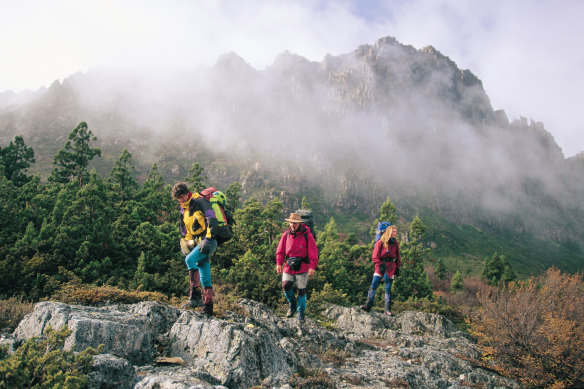
The four-day trail is prone to some steep and rocky turns.Credit: Tourism Tasmania / Don Fuchs
We’re on a four-day guided hike along Tasmania’s Overland Track, a trail that winds 65 kilometres south through the state’s alpine wilderness. The only hint of luxury will be the private cabins we’ll stay in each night, offering the twin comforts of a hot shower and glass of wine (or three) after a day’s walking.
My group of seven friends – women in our 50s and 60s who met through our over-35s football team – are joined by four others and two guides on the Tasmanian Walking Company’s trek. It’s a warm April day as we set off along boardwalks, passing through button grass and a waterfall en route to Cradle Mountain. The track is on a steady incline but once past Crater Lake it takes a steep and rocky turn.
One of the walkers is struggling on the uphill sections, and as the trail steepens, his pace slows further. Once he arrives at a rest spot halfway to Marions Lookout, the decision is made for him to be “turned around” and not continue with the walk.
It’s a difficult choice, but there’s a guide saying that goes something like, “With some walkers, if we didn’t turn them around, god might have”.
One of our group also eyes off the next section, a near-vertical gradient thoughtfully lined with chains, and thinks she might also head in a downward direction.
Just months before our trip, she’d experienced a serious health setback, but decides to come despite a couple of fresh physical limitations. She expected some challenges but not rock scrambling on day one.
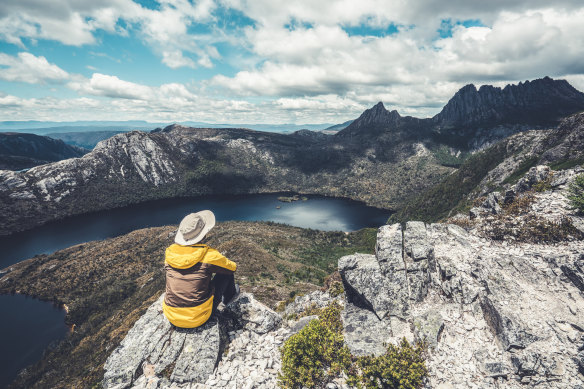
Rugged landscape around Marions Lookout, perched above Dove Lake.Credit: iStock
We convince her to push on, after a few of us offer to carry her pack. Just when we think our jellied thighs have given their all, we manage to push, pull and manhandle ourselves and a second pack up the chains. Pack-free, our friend manages the last steep section to arrive at Marions Lookout.
With backpacks dumped and heart rates out of the red zone, we take in the dramatic sights of Dove Lake below, and Cradle Mountain ahead.
But time – and daylight – is ticking on. As we set off after lunch, minus one group member and a guide, a helicopter lands on the rocky outcrop to collect an injured trekker. It’s a surreal reminder that from here on, the only way on or off the Overland is on foot or by chopper.
Skirting Cradle Mountain, we snake deeper into the rugged landscape, leaving the day trippers, almond lattes and mobile coverage behind. Over the next few hours, my two litre water bottle empties, and we push on through terrain that is rocky, narrow and hemmed in by bushes.
The group strings out and rumblings begin among the slower walkers about how they’ll make the next hour let alone the next three days. Who chose this trek? Why didn’t we go with Wineglass Bay, and its relaxing day’s sailing on a private yacht option?
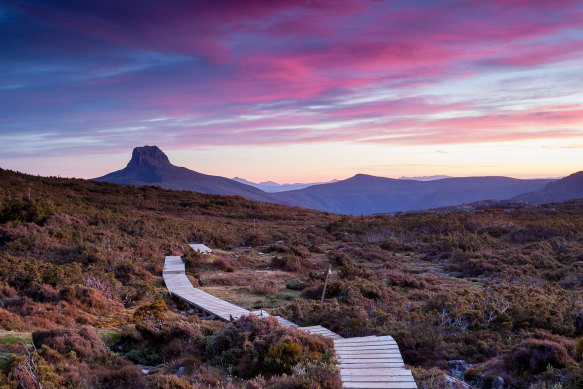
Dazzling dusk skies: being the slowest can have its perks on the Overland Track.Credit: iStock
Our walking crocodile continues across an alpine plateau, and when the sun sets, it turns out being the slowest walkers on the Overland comes with a silver, rose and golden lining. High on the ridge, we’re treated to a light display that turns buttery yellow, then orange and finally a flaming pink. For a short while, we’re the lucky ones, exposed to nature’s own Vivid lights show, a spectacle missed by all those other speedy walkers tucked into cabins and tents in the valley below.
With head torches now on, we’ve still got a couple of hours to go, and I’m hit by a dehydration headache, shortly followed by nausea. I focus on keeping my stomach contents in place while navigating the slippery downhill trail, trying not to twist an ankle or crack a rib. We pass the public huts, and eventually, after nine hours on our feet, the Tasmanian Walking Company cabin takes shape in the darkness.
Inside, I lie down on a window seat, guzzling water and ibuprofen, while a search party is raised to find our other guide. She’s still on the track, having set out in the dark along the same route we’d covered.
They find her a short distance from the hut, safe, shaken but not overly stirred. “I was a bit freaked out,” she says. “At times the mist was so thick, I could barely see my hand. And all these red eyes stared at me from the bush.”
The next morning, muscles are sore, but we’re in good shape other than a few blisters. Now that we’re over the shock and awe of the first day, our legs feel more attuned to the weight of the backpacks and the remoteness and the rugged beauty of the Overland starts to seep in.
We walk 12 to 15 kilometres a day, passing through ancient mossy forests, craggy peaks and moorlands, sharing backstories, laughs and occasional tears as we get to know our fellow trekkers.
There’s willowy Skye in her early 50s, funny and warm, who’s with her dad David, a farmer with the love of a yarn and a poem. Then there’s Philip, an Irish-born Sydney executive who one night performs an unexpected rendition of Danny Boy that leaves most in the hut sniffling.
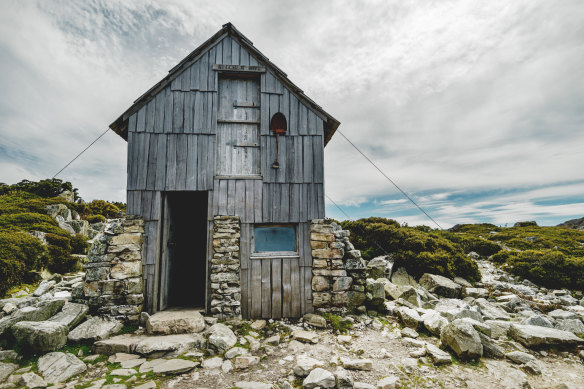
A basic kitchen hut along the Overland Track – sleeping accommodation is more salubrious.Credit: iStock
An experienced trekker, he never complains about being held up by our slow pace. Rather, he’s usually hanging out at the rear, chatting, offering advice on the best rock to take, lending a hand over an awkward log. And our guides. Think graceful mountain goats, now add a wide smile and a 25-kilogram pack, and you’re getting close.
Matilda, 23, and Danah, 29, are intrepid souls who keep us fed, moving, warm and in good humour. They even maintain a straight face as we whinge while lifting our 10-kilogram packs.
My football buddies are a robust bunch, but there are parallels between our trek prep and our pre-season football training – both are patchy. One of us is in borrowed boots, has done no practice walks, yet sails through, with a chamomile tea in one hand, taking photos with the other.
For the most part we’re fit enough to handle the distance, the descents and climbs. But the trails are rough – rooty, rocky and muddy, and sometimes all three at once. On occasions, we inch our way across slippery logs and slog up through creeks.
But some of the toughest challenges arrive in the form of wildlife. On a drizzly day, leeches latch onto ankles, tummies and feet. David finds one attached to his tongue, and a few hours later, Erika wonders if she has something in her eye. But it’s not grit or a twig. Instead, a waving leech is firmly adhered to her left eyeball. It’s eventually dislodged, but that night back at our final hut, more wildlife encounters await.
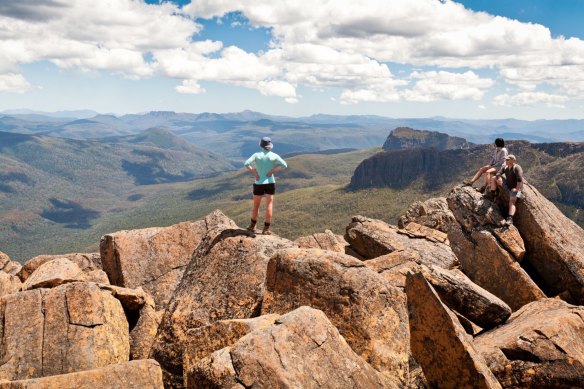
Views from Mount Ossa on the Overland Track.
The guides have forewarned us of a rodent infestation they say can’t be tackled by poison owing to the rats and mice being a native species. Native or otherwise, as soon as the hut lights go out, creatures stream through the ceiling space, the wall cavities and along hallways. My roomie, Erika, who barely flinches with a leech in her eye, hardly sleeps for fear of a set of tiny feet scurrying over her sleeping bag.
The next day is our last, when we leave the Overland Track and head along the Arm River track, a day’s walk as beautiful and as challenging as anything on the Overland.
Eight hours later, we emerge feeling like Amazonian women and men. We’ve a sense of achievement that matches the camaraderie that’s grown over the past four days. The Overland is tough. It tests us physically and emotionally, even staying in cabins with hot water and wine.
For our group of mixed-fitness over-50s, we probably chose the wrong trek. We’d had to dig deep, some deeper than others, to get through. But in the end, having discovered the kindness of strangers and bonded with friends, old and new, over the beauty, trials and rodents of the Overland Track, it turned out to be the right trek.
The writer traveller at her own expense.
Sign up for the Traveller Deals newsletter
Get exclusive travel deals delivered straight to your inbox. Sign up now.